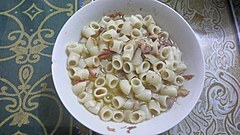
Chicken soup is a soup made from chicken, simmered in water, usually with various other ingredients. The classic chicken soup consists of a clear chicken broth, often with pieces of chicken or vegetables; common additions are pasta, noodles, dumplings, or grains such as rice and barley. Chicken soup has acquired the reputation of a folk remedy for colds and influenza, and in many countries is considered a comfort food.

Macaroni salad is a type of pasta salad, served cold, made with cooked elbow macaroni and usually prepared with mayonnaise. Much like potato salad or coleslaw in its use, it is often served as a side dish to barbecue, fried chicken, or other picnic style dishes. Like any dish, national and regional variations abound but generally it is prepared with raw diced onions, dill or sweet pickles and celery and seasoned with salt and pepper.
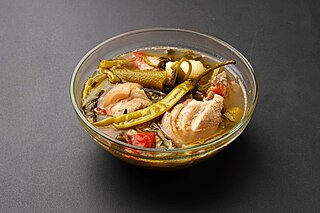
Sinigang is a Filipino soup or stew characterized by its sour and savory taste. It is most often associated with tamarind, although it can use other sour fruits and leaves as the souring agent. It is one of the more popular dishes in Filipino cuisine. The soup is usually accompanied by rice. In 2021, sinigang was rated as the world's best vegetable soup by TasteAtlas.

Kare-kare is a Philippine stew that features a thick savory peanut sauce. It is generally made from a base of stewed oxtail, beef tripe, pork hocks, calves' feet, pig's feet or trotters, various cuts of pork, beef stew meat, and occasionally offal. Vegetables, such as eggplant, Chinese cabbage, or other greens, daikon, green beans, okra, and asparagus beans, are added. The stew is flavored with ground roasted peanuts or peanut butter, onions, and garlic. It is colored with annatto and can be thickened with toasted or plain ground rice. Variations of kare-kare can be made with seafood, such as prawns, squid, and mussels, or exclusively from vegetables.

Pancit, also spelled pansít, is a general term referring to various traditional noodle dishes in Filipino cuisine. There are numerous types of pancit, often named based on the noodles used, method of cooking, place of origin, equal and constant diameter or the ingredients. Most pancit dishes are characteristically served with calamansi, as its freshly-squeezed juice may be used for additional seasoning.

Noodle soup refers to a variety of soups with noodles and other ingredients served in a light broth. Noodle soup is a common dish across East Asia, Southeast Asia and the Himalayan states of South Asia. Various types of noodles are used, such as rice noodles, wheat noodles and egg noodles.

Sopa de mondongo is a soup made from diced tripe slow-cooked with vegetables such as bell peppers, onions, carrots, cabbage, celery, tomatoes, cilantro, garlic or root vegetables. The dish is generally prepared in former Spanish colonies in Latin America, Caribbean, and in the Philippines.
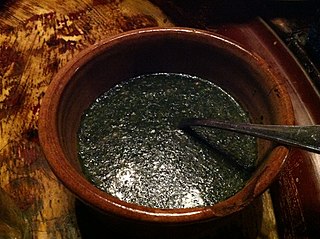
Mulukhiyah, also known as molokhia, molohiya, or ewedu, is a dish made from the leaves of Corchorus olitorius, commonly known in English as jute mallow,nalta jute,tossa jute and denje'c'jute. It is used as a vegetable and is mainly eaten in Egypt, the Levant, Sudan, Cyprus, Libya, Tunisia and Algeria. It is called “Saluyot” in the Philippines. Mulukhiyah is rather bitter, and when boiled, the resulting liquid is a thick, highly mucilaginous broth; it is often described as "slimy", rather like cooked okra. Mulukhiyah is generally eaten cooked, not raw, and it is either eaten chopped and sautéed in oil, garlic and cilantro like in Syria or turned into a kind of soup or stew like in Egypt, typically bearing the same name as the vegetable in the local language. Traditionally mulukhiyah is cooked with chicken or at least chicken stock for flavor and is served with white rice, accompanied with lemon or lime.

Caldo de pollo is a common Latin American soup that consists of chicken and vegetables.
Hodge-podge or hotch potch is a soup or stew, usually based on diced mutton or other meat, with green and root vegetables. It is familiar in different versions in Britain and North America and is particularly associated with Scotland.

Macaroni soup is soup that includes macaroni. The food is a traditional dish in Italy, and is sometimes served with beans, which is known as pasta e fagioli, and was also included in Mrs Beeton's Book of Household Management where the connection with Italy is mentioned and the dish includes parmesan cheese. In the early 19th century, macaroni soup was one of the most common dishes in Italian inns.

Olivier salad is a traditional salad dish in Russian cuisine, which is also popular in other post-Soviet countries and around the world. In different modern recipes, it is usually made with diced boiled potatoes, carrots and brined dill pickles, together with optional vegetable or fruit ingredients such as green peas, eggs, celeriac, onions and apples, optional meat ingredients such as diced boiled chicken, bologna sausage, ham, or hot dogs, with salt, pepper and mustard sometimes added to enhance flavor, and dressed with mayonnaise. In many countries, the dish is commonly referred to as Russian salad, in Brazil it is called Maionese, in a few Scandinavian countries it is called italiensk salat and in Dutch it is called huzarensalade. In former Yugoslavian countries it is called ruska salata or francuska salata. In Romania it is known as "salata (de) boeuf."

Nilaga is a traditional meat stew or soup from the Philippines, made with boiled beef or pork mixed with various vegetables. It is typically eaten with white rice and is served with soy sauce, patis, labuyo chilis, and calamansi on the side.
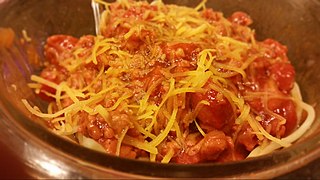
Filipino spaghetti is a Filipino adaptation of Italian spaghetti with Bolognese sauce. It has a distinctively sweet sauce, usually made from tomato sauce sweetened with brown sugar and banana ketchup. It is typically topped with sliced hot dogs or smoked longganisa sausages, giniling, and grated cheese. It is regarded as a comfort food in Philippine cuisine. It is typically served on almost any special occasion, especially on children's birthdays.
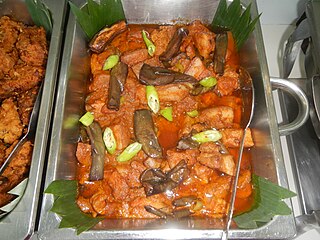
Binagoongan is a Filipino cooking process consisting of vegetables or meat sautéed or braised in bagoong alamang, garlic, black peppercorns, and bay leaves. Some recipes also add pineapples, chilis, or coconut cream to balance the flavors. The dish is characteristically quite salty with a strong umami flavor, which is why it is always paired with white rice and never eaten on its own. It is very similar to pinatisan which is cooked with patis, one of the by-products of fermenting bagoong.

Philippine asado refers to two different Filipino braised meat dishes. The name originates from Spanish asado ("grilled"), a reference to the original dish it was applied to, the Chinese-Filipino version of char siu barbecues usually known as pork asado. However, the Filipino versions have evolved to be braised, not grilled. The other Filipino dish also known as asado is asado de carajay. Unlike the Chinese-derived version, it is savory rather than sweet.

Indonesian noodles are a significant aspect of Indonesian cuisine which is itself very diverse. Indonesian cuisine recognizes many types of noodles, with each region of the country often developing its own distinct recipes.

Carne norte guisado, also known as corned beef guisado, is a Filipino dish made from shredded canned corned beef sautéed with onion rings. It's a very simple dish and is popularly eaten for breakfast with white rice or pandesal. Finely diced potatoes, carrots, scallions, tomatoes, cabbage, bell pepper, and garlic may also be added. A notable variant of the dish is sinabawang corned beef, which just adds beef stock or water to the dish after sautéing, making it soupier.

